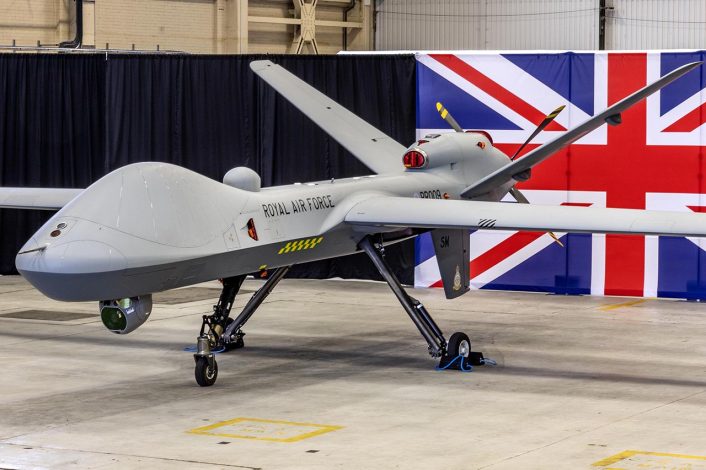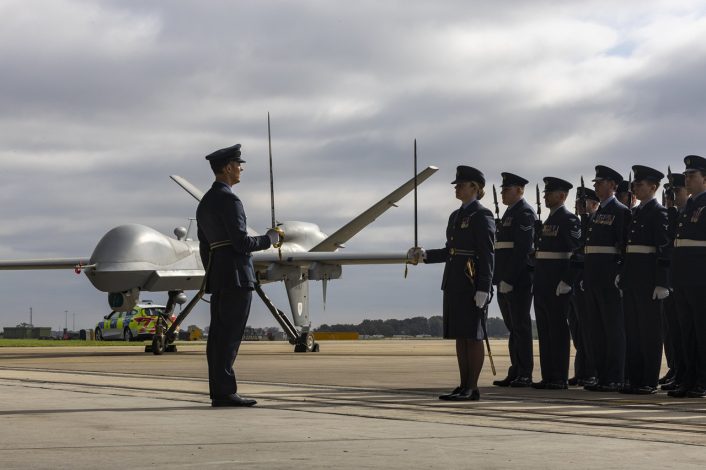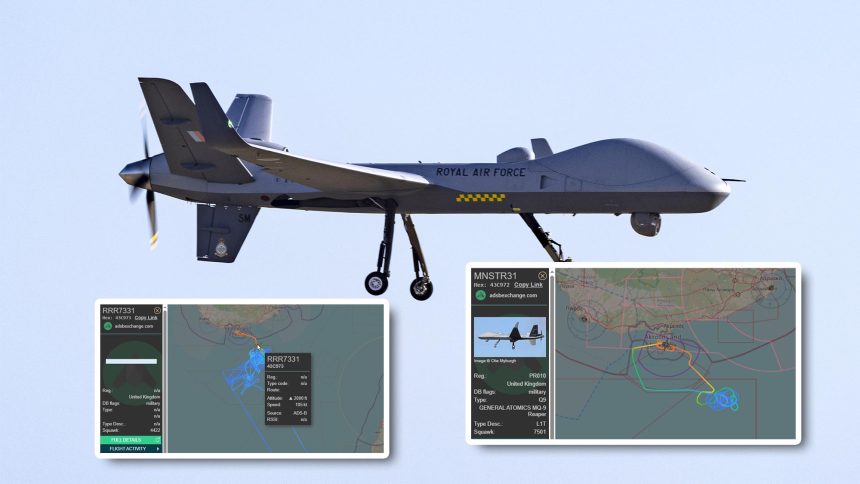Activity visible on flight tracking websites reveals that the Royal Air Force’s MQ-9B Protector RG1 has been deployed to RAF Akrotiri as the type ramps up operations to replace the now retired MQ-9A Reaper.
At least two Protector RG1s have apparently been deployed to RAF Akrotiri – a UK base within one of the small portions of British territory on the Mediterranean island of Cyprus – and have commenced flight operations over the Mediterranean Sea. The first aircraft was documented by enthusiasts using popular flight tracking websites on Oct. 15, 2025, with a subsequent follow up flight on Oct. 16.
This airframe, PR010, had previously flown from RAF Waddington in the UK and subsequently had had its identity logged, allowing it to display with full information.
MNSTR31 – PR010 – 43C972 https://t.co/IaxjcI2nVB pic.twitter.com/DeQxrIBh51
— Pierre Davide Borrelli (@PierreDavideB) October 16, 2025
On Oct. 18, another flight was noted, using the callsign ASCOT 7331 (RRR7331), operating over the Mediterranean Sea south of Cyprus at or around 25,000 feet. The aircraft displayed without type and registration information on sites such as ADS-B Exchange and Flightradar24.com, but this is common for newly delivered aircraft. Rather than transmitting this data itself, the aircraft transmits a six character alphanumeric code, known as a Mode S address or, more colloquially, a hex code, that in theory acts as a unique airframe identifier. In many cases, these codes are assigned in consecutive blocks which allows for informed speculation as to the correct tie-up.
The track was first picked up at around 0355 UTC, and the aircraft was tracked returning to RAF Akrotiri just before 1300 UTC on Oct. 18, 2025. It used the Mode S address 43C973, while the other airframe, which displayed with full information, used 43C972. We can therefore assume with a reasonable amount of confidence that ASCOT 7331 was Protector RG1 airframe PR011.
RRR7331 #RAF #UAV active south of #Cyprus. 1034z pic.twitter.com/6xOdkleA5X
— nde (@5472_nde) October 18, 2025
As far as is publicly known, these flights are the first for the RAF’s Protector RG1s outside of UK or U.S. airspace. It had already been announced last month that preparations were underway for the type’s first operational deployment. At the time it was unclear how long the RAF’s older MQ-9A Reaper fleet had left in service, but with the more recent news that the MQ-9A was withdrawn on Sept. 30, the requirement for a rapid rollout of Protector onto frontline duties became very apparent.
The flight paths of the missions suggest that the aircraft are primarily engaged in trials and training, using the danger areas over the seas south of Cyprus much like the British Army’s Watchkeeper previously did. Operational sorties by the RAF’s Reaper fleet were never known to have been launched from Akrotiri, instead flying from Ali Al Salem Air Base in Kuwait, though it does host the RAF’s permanent detachment of Typhoon FGR4s on Operation Shader.
Some suggestions have been made online that the Protector operations are linked to monitoring of Israel and, specifically, Gaza. At least one portion of the Oct. 18 sortie did involve a flight towards this area, before making an about turn and heading back towards Cyprus. It would have been possible for the aircraft’s sensors, from altitude, to look over towards Israel’s northern border with Lebanon, but the aircraft remained quite distant from Gaza and it’s questionable how much value could have been gained from such a short intelligence collection window. Instead, the flight path towards Israel was most likely intended to mimic what could be a potential flight path for future operational missions, following a similar track to one frequently used by the RAF’s Typhoons to get to and from operational areas over Iraq and Syria.
#RAF Operation #Shader package heading out for another mission. Tanker support + Typhoon(s) 0803z pic.twitter.com/VfJhN14TuC
— nde (@5472_nde) April 10, 2025
The RAF has controversially flown surveillance flights over Gaza since October 2023, which the UK Government says have been primarily tasked with locating hostages held by Hamas. Following the recent ceasefire deal, these missions have ended.
The Protector RG1
Replacing the RAF’s hard-worked Reaper fleet, the Protector RG1’s most notable difference is its clearance by UK authorities to operate in unsegregated airspace. This has permitted the aircraft to fly directly from RAF Waddington and operate in UK skies, which never occurred with the Reaper.
Protector carries a similar base ISR payload to the Reaper, complete with an integrated electro-optical/infrared camera turret and multi-mode radar. Additional ISR payloads frequently carried by the Reaper can also, in theory, be carried by Protector, alongside new payloads under development which could see the Protector utilised for airborne early warning (AEW) and maritime patrol missions.

In UK service, the Protector will be able to use weapons like the Paveway IV precision guided bomb and Brimstone missile, both widely used within the RAF’s air to surface weapon inventory. The Reapers, instead, relied upon Hellfire missiles and Paveway II bombs – neither of which saw current use on other RAF types. This vastly simplifies the Protector’s potential logistics chain and would make co-locating them alongside Typhoons, for example, at Akrotiri, a much simpler prospect.
16 Protectors have been ordered by the RAF, and at least 10 are active either with the RAF or in the U.S. for test and evaluation purposes. Full operating capability for the new type is expected to be declared in 2026, and this initial deployment is likely one of the requirements that must have been fulfilled ahead of that milestone.
Reaper at Waddington
An official retirement ceremony for the MQ-9A Reaper was held at RAF Waddington with Honorary Air Commodore Prince Edward, The Duke of Edinburgh, as a VIP guest. The images released from this ceremony, though, showed something very interesting – an RAF MQ-9A Reaper on UK soil. The airframe is notably shown with its cheek-mounted ISR antennas, a modification which began appearing in many of the RAF’s official Reaper images some years ago.

As mentioned above, RAF Reapers were not able to operate normally from UK airfields, and as such they spent their entire service careers overseas. It’s possible that the airframes touched down on UK soil in between operations, though this would have been in their air-transportable crates in a disassembled state.
The airframe on display for the ceremony appears to be ZZ202. No information has been forthcoming regarding the future for the RAF’s Reaper airframes. If at least some of them have been moved back to the UK, there is not only the potential for them to be placed into reserve, but also the possibility that at least one might find its way into a museum. Both the Imperial War Museum at Duxford as well as the Royal Air Force Museum in Hendon, London, have MQ-1 Predators in their collection, on loan from the United States. An RAF example of an MQ-9 would no doubt be a popular piece as well as a tool to showcase the RAF’s recent operations and more modern capabilities.









